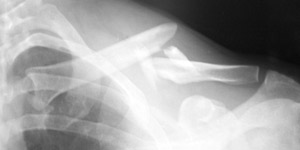Common Cycling Shoulder Injuries

Severe Clavicle Fracture
– I would consider surgical repair
Whether commuting to work, out for a weekend ride, or in a competitive triathalon, unfortunately crashes are at times are unavoidable. Serious shoulder and upper extremeity injuries are frequently the result.
Clavical Fractures
The clavicle fracture is probably the most common shoulder injury following a bike crash. Traditional orthopedic teaching was that nearly all clavicle fractures would heal without intervention and that those patients all did well. However, recent orthopedic publications examining these injuries more closely have not painted such a rosy picture. These studies have initiated a trend towards more aggressive (at times surgical) management of these fractures. These studies indicate that achieveing an accurate reduction of the bone fragments will speed healing while diminishing the risk of nonunion, shoulder weakness, and loss of shoulder motion. Therefore, I now recommend surgery for patients with severe fractures that I believe are more prone to develop problems when treated conservatively.
Acromio-Clavicular Joint Injury/Shoulder Separation:

Severe grade 5 acromio-clavicular
joint separation
This is the second common form of shoulder injury that occurs following road bike crashes. Fortunately most shoulder seperations will be effectively treated with a sling and rest. However, patients with more dramatically displaced seperations probably will do better in the end if the joint is surgically reconstructed. Recently, a novel arthroscopic assisted technique has changed the way I approach treatment of this injury. I am able to reduce and stabilize the AC joint with precision, while avoiding the aggressive open exposure formerly necessary.
Rotator Cuff Tears:
Rotator cuff tears also frequently result from a hard fall on the shoulder. This injury is less obviously evident because there is typically no resulting deformity about the shoulder to alert one to the problem. However, the rotator cuff injury can be just as profound in terms of related pain and disability. For more information on the topic, please move to the dedicated section on rotator cuff tears.
